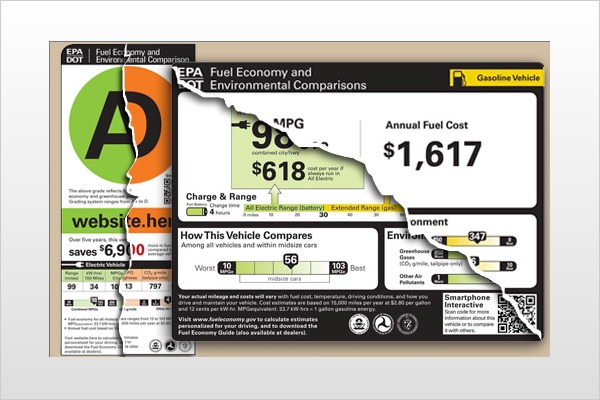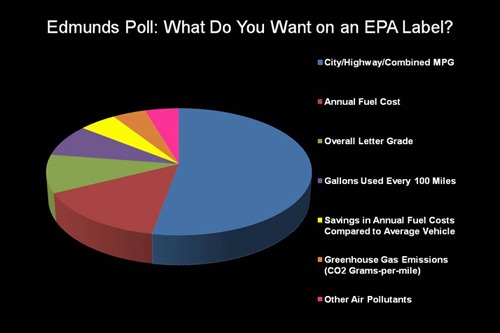
The results of a recent Edmunds poll showed that fuel economy ratings, annual fuel costs and — perhaps surprisingly — an overall fuel economy letter grade were the top three most important pieces of information consumers want from a fuel economy label. Edmunds conducted the survey as the Environmental Protection Agency (EPA) and the Department of Transportation consider proposed redesigns of the fuel economy labels found on the window stickers of new cars. The EPA expects to make a decision by early 2011, and the new label will first appear on 2012 models. The survey first asked readers to envision their perfect EPA label, and rank numerous pieces of information in order of importance. The pie chart below illustrates the most popular responses.

Not surprisingly, more than 55 percent of respondents believe that the vehicle's city, highway and combined fuel miles per gallon (mpg) ratings were the most important numbers to display on a fuel economy label. These are the mpg numbers that everyone knows and are the easiest for comparisons to other vehicles. It's safe to say that this information will be on any incarnation of the EPA sticker. How prominently it will be displayed remains to be seen.
Annual fuel cost, a figure that is listed on the current EPA label, ranked 2nd, with 15 percent of the vote. The majority of poll participants, however, felt that this item could use some refinement. The Edmunds survey asked readers if they would prefer to see a monthly fuel cost total instead of an annual one. Nearly 55 percent voted in favor of the monthly cost.
The overall letter grade was most important to 10 percent of respondents, and ranked 3rd in the survey. Even that low percentage was something of a surprise to Edmunds editors, because in a previous poll, 82 percent of reader respondents said they were against the EPA's proposed letter grade label. It's unclear whether the letter grade will be part of the final label design. Consumer groups are in favor of it, citing ease of use, while dealer groups vehemently oppose it, saying that grades would confuse consumers, who might mistake them for an assessment of the car overall.
"Gallons per hundred miles" ranked 4th in the survey. This is an alternate — and some would say more accurate — way of thinking about fuel consumption. It expresses fuel use in gallons per 100 miles, rather than miles per gallon. The measurement, which is outlined in this article, is not on the current EPA label, but has been included on both proposed labels.
"Savings in annual fuel costs compared to the average vehicle" ranked 5th. This figure appears only on the letter-grade version of the proposed fuel economy label and is designed to be used as a comparison to other vehicles' fuel costs. The EPA arrives at the figure by estimating the five-year fuel cost of the average gasoline vehicle ($10,000). If a new car costs $8,000 to fuel over five years, the amount on the sticker would read $2,000.
Information on greenhouse gas emissions and other air pollutants was considered the least important by survey respondents. Greenhouse gas emissions are expected to be included in some fashion on the new label, but environmental groups have also complained that neither version of the proposed EPA label accounts for upstream emissions, which is the pollution resulting from the electricity generation.